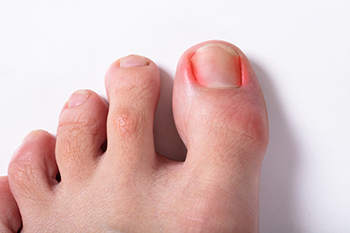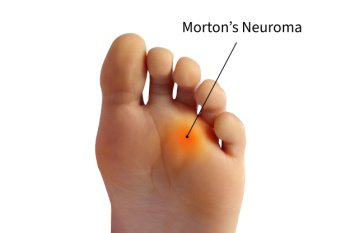March 2025
Preventing Ingrown Toenails on the Trail

- When preparing for a long hike, paying extra attention to your toenails is essential to prevent painful ingrown nails. Regular trimming is vital. Clip nails straight across to avoid curvature that pushes skin. Keeping nails short reduces friction inside boots and prevents nail edges from embedding into surrounding tissue. Moisturize cuticles daily and use a gentle file to smooth rough edges, ensuring proper alignment and comfort. After trimming, allow nails to dry thoroughly and inspect them for signs of irritation. Proper care and proactive maintenance enable you to enjoy hiking adventures free from discomfort and setbacks, ensuring your feet remain healthy and resilient along every challenging trail. For persistent issues, unusual nail shapes, or ingrown toenails, it is suggested that you consult a podiatrist to receive expert advice tailored to your needs.
Ingrown toenails can become painful if they are not treated properly. For more information about ingrown toenails, contact Dr. Kirk Sherris of Liberty Bay Foot & Ankle. Our doctor can provide the care you need to keep you pain-free and on your feet.
Ingrown Toenails
Ingrown toenails occur when a toenail grows sideways into the bed of the nail, causing pain, swelling, and possibly infection.
Causes
- Bacterial infections
- Improper nail cutting such as cutting it too short or not straight across
- Trauma to the toe, such as stubbing, which causes the nail to grow back irregularly
- Ill-fitting shoes that bunch the toes too close together
- Genetic predisposition
Prevention
Because ingrown toenails are not something found outside of shoe-wearing cultures, going barefoot as often as possible will decrease the likeliness of developing ingrown toenails. Wearing proper fitting shoes and using proper cutting techniques will also help decrease your risk of developing ingrown toenails.
Treatment
Ingrown toenails are a very treatable foot condition. In minor cases, soaking the affected area in salt or antibacterial soaps will not only help with the ingrown nail itself, but also help prevent any infections from occurring. In more severe cases, surgery is an option. In either case, speaking to your podiatrist about this condition will help you get a better understanding of specific treatment options that are right for you.
If you have any questions please feel free to contact our office located in Poulsbo, WA . We offer the newest diagnostic and treatment technologies for all your foot and ankle needs.
The Importance of Timely Care for Foot Puncture Wounds

A foot puncture wound occurs when a sharp object penetrates the skin, creating a small but potentially deep injury. Common causes include stepping on nails, glass, splinters, or other sharp debris. Outdoor environments, construction sites, and walking barefoot increase the risk of these injuries. Although the wound may appear minor, prompt care is essential to prevent infection and complications. Bacteria can enter the deeper tissues, leading to serious infections, such as cellulitis or abscess formation. Delayed treatment can also increase the risk of foreign objects remaining in the wound, causing prolonged pain and inflammation. If you have sustained a puncture wound on the foot, it is suggested that you promptly consult a podiatrist who can provide appropriate treatment solutions.
Wound care is an important part in dealing with diabetes. If you have diabetes and a foot wound or would like more information about wound care for diabetics, consult with Dr. Kirk Sherris from Liberty Bay Foot & Ankle. Our doctor will assess your condition and provide you with quality foot and ankle treatment.
What Is Wound Care?
Wound care is the practice of taking proper care of a wound. This can range from the smallest to the largest of wounds. While everyone can benefit from proper wound care, it is much more important for diabetics. Diabetics often suffer from poor blood circulation which causes wounds to heal much slower than they would in a non-diabetic.
What Is the Importance of Wound Care?
While it may not seem apparent with small ulcers on the foot, for diabetics, any size ulcer can become infected. Diabetics often also suffer from neuropathy, or nerve loss. This means they might not even feel when they have an ulcer on their foot. If the wound becomes severely infected, amputation may be necessary. Therefore, it is of the upmost importance to properly care for any and all foot wounds.
How to Care for Wounds
The best way to care for foot wounds is to prevent them. For diabetics, this means daily inspections of the feet for any signs of abnormalities or ulcers. It is also recommended to see a podiatrist several times a year for a foot inspection. If you do have an ulcer, run the wound under water to clear dirt from the wound; then apply antibiotic ointment to the wound and cover with a bandage. Bandages should be changed daily and keeping pressure off the wound is smart. It is advised to see a podiatrist, who can keep an eye on it.
If you have any questions, please feel free to contact our office located in Poulsbo, WA . We offer the newest diagnostic and treatment technologies for all your foot care needs.
What Is Morton’s Neuroma?

Morton’s neuroma is a painful condition that affects the ball of the foot, typically between the third and fourth toes. It occurs when the tissue surrounding the nerve becomes thickened, often due to irritation or pressure. The symptoms include a sharp, burning pain, a sensation of something being stuck in your shoe, or numbness in the toes. The pain usually worsens with activity or wearing tight shoes, particularly high heels. The primary causes of Morton’s neuroma are repetitive pressure on the feet, such as from tight shoes or high heels, flat feet, or abnormal foot mechanics. A podiatrist can help diagnose Morton’s neuroma through a physical examination and imaging tests. Treatment options include footwear changes, padding, custom orthotics to reduce pressure, and anti-inflammatory medication. In some cases, injections or surgical removal of the affected tissue may be necessary. If you have any of the above symptoms, it is suggested that you schedule an appointment with a podiatrist for proper diagnosis and appropriate care.
Morton’s neuroma is a very uncomfortable condition to live with. If you think you have Morton’s neuroma, contact Dr. Kirk Sherris of Liberty Bay Foot & Ankle. Our doctor will attend to all of your foot care needs and answer any of your related questions.
Morton’s Neuroma
Morton's neuroma is a painful foot condition that commonly affects the areas between the second and third or third and fourth toe, although other areas of the foot are also susceptible. Morton’s neuroma is caused by an inflamed nerve in the foot that is being squeezed and aggravated by surrounding bones.
What Increases the Chances of Having Morton’s Neuroma?
- Ill-fitting high heels or shoes that add pressure to the toe or foot
- Jogging, running or any sport that involves constant impact to the foot
- Flat feet, bunions, and any other foot deformities
Morton’s neuroma is a very treatable condition. Orthotics and shoe inserts can often be used to alleviate the pain on the forefront of the feet. In more severe cases, corticosteroids can also be prescribed. In order to figure out the best treatment for your neuroma, it’s recommended to seek the care of a podiatrist who can diagnose your condition and provide different treatment options.
If you have any questions, please feel free to contact our office located in Poulsbo, WA . We offer the newest diagnostic and treatment technologies for all your foot care needs.
Do Your Child's Feet Hurt?
Intrinsic Foot Strengthening Exercises

Intrinsic foot muscles play a vital role in maintaining the structure and function of the feet. These muscles are located within the foot itself and are responsible for supporting the arches, controlling toe movements, and stabilizing the foot during walking and running. Weakness in these muscles can contribute to foot pain, ankle discomfort, and conditions such as flat feet. Strengthening these muscles through targeted exercises can help alleviate pain and improve foot function. One effective exercise involves picking up small objects with the toes, which helps activate and strengthen the intrinsic muscles. Another exercise is towel curls, where the toes are used to scrunch a towel placed on the floor. Strengthening the intrinsic muscles of the feet can also improve balance and prevent overuse injuries. If you have foot pain, it is suggested that you consult a podiatrist who can treat various foot conditions, and guide you on additional foot strengthening exercises.
Exercising your feet regularly with the proper foot wear is a great way to prevent injuries and build strength. If you have any concerns about your feet, contact Dr. Kirk Sherris from Liberty Bay Foot & Ankle. Our doctor can provide the care you need to keep you pain-free and on your feet.
Exercise for Your Feet
Exercise for your feet can help you gain strength, mobility and flexibility in your feet. They say that strengthening your feet can be just as rewarding as strengthening another part of the body. Your feet are very important, and we often forget about them in our daily tasks. But it is because of our feet that are we able to get going and do what we need to. For those of us fortunate enough to not have any foot problems, it is an important gesture to take care of them to ensure good health in the long run.
Some foot health exercises can include ankle pumps, tip-toeing, toe rises, lifting off the floor doing reps and sets, and flexing the toes. It is best to speak with Our doctor to determine an appropriate regimen for your needs. Everyone’s needs and bodies are different, and the activities required to maintain strength in the feet vary from individual to individual.
Once you get into a routine of doing regular exercise, you may notice a difference in your feet and how strong they may become.
If you have any questions please feel free to contact our office located in Poulsbo, WA . We offer the newest diagnostic and treatment technologies for all your foot and ankle needs.








